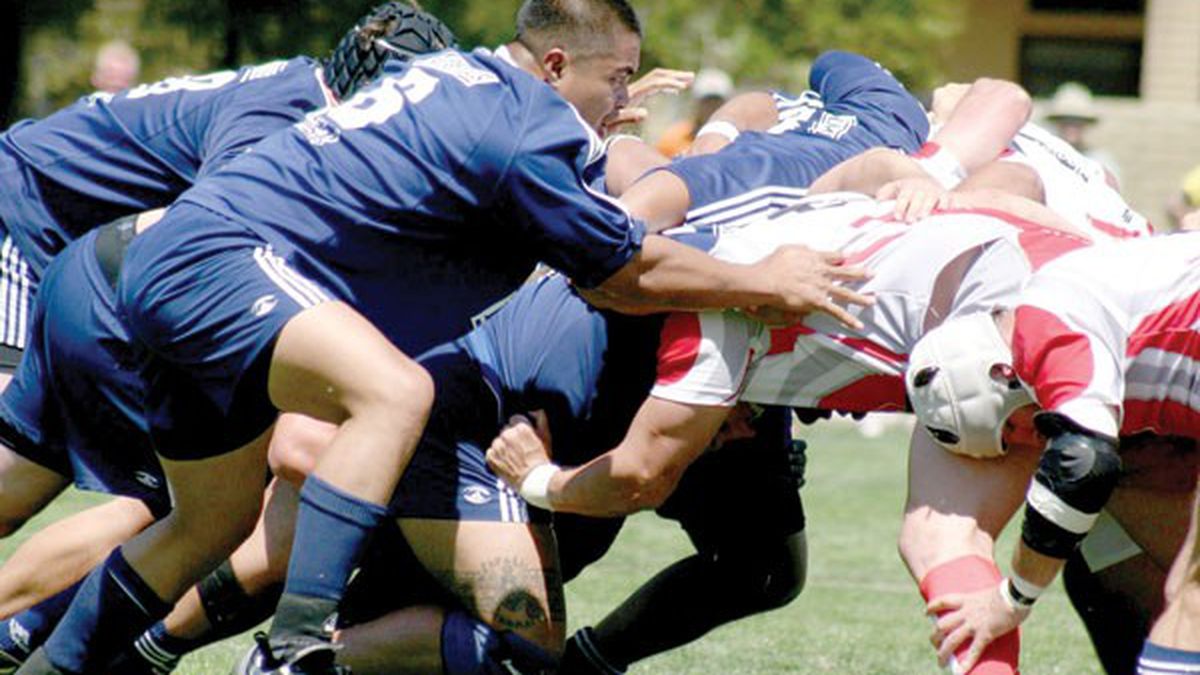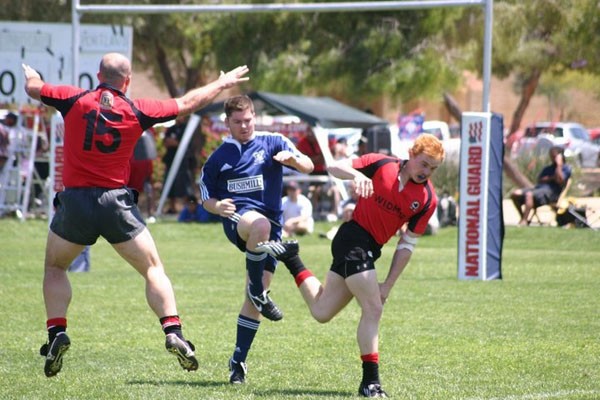Big hit, Cameron Kahangi thinks. Big hit.
A wall forms behind the nineteen-year-old hooker. Each player interlocks his arms and legs with those of his brethren, shoulders bracing, knees on the ground. The other team does the same.
“Engage!” shouts the referee.
The two sides collide, letting out a deep grunt that echoes off the ground. They push harder, dig deeper, until the ball enters the huddle, known as a “scrum.” Kahangi kicks the ball back to the scrum-half, a player who is waiting at the back of the formation. The scrum breaks and the defense spreads itself across the field, waiting for the next forward movement, or “phase.”
The men of the Diablo Valley Rugby Club’s Olde Gaels devote every weekend of the spring to a sport that roughs up their bodies but offers little in the way of appreciation. They have no hopes for scholarships, and even at the collegiate level they will receive no recognition as NCAA athletes. But rugby is not without its rewards. “This game gets under your skin,” said head coach Harry Batten. Most players plan on playing as long as their bodies hold up.
After the game all but evaporated in the United States following the 1924 Olympics, it remained underground, kept alive by just a few dozen men’s clubs in California and the Northeast. Now the Olde Gaels are one of but a thousand men’s clubs around the country. And despite having to overcome neglect, insufficient resources, and the absence of concrete incentives, more and more kids are starting to choose the game over other American sports. This year, ESPN broadcast collegiate matches and NBC featured national games.
The Olde Gaels contrast themselves with football and soccer players they view as egomaniacal. As proof of their sport’s superiority, they point to its continuous action, the flexibility to play both offense and defense, and the gentlemanly aspects of the game. After all, when the match ends, rivals shake hands and share beers, the violence a distant memory.
Kahangi and his teammate Danny Corbett are fond of the old saying “Soccer is a gentlemen’s sport for hooligans. Rugby is a hooligan’s sport for gentlemen.”
History seems to bear them out. Rugby has always been an upper-middle-class sport played primarily by those who could afford the best education. The hooligan’s game favored by gentlemen started where many gentlemen also get their start — on the playing fields of boarding schools in England. During the 1830s, high-school boys brought the game to Oxford and Cambridge and started challenging other universities to compete against them.
Rugby arrived on American soil in 1874 through the collegiate system, when McGill University took their English expats down to Harvard. The Boston players were accustomed to a simple carrying game, but they were soon enthralled by a version that was both faster and continuous. Each time a Canadian ball carrier was tackled and fell to the ground, he pushed the ball to the back of the pile, where a teammate was waiting to pick it up and throw it laterally to an adjacent player. The ball moved up the field that way: lateral passes, forward movement, and, eventually, if the scheme proved successful, a final down in the end zone. Harvard adopted this method of nonstop, physically demanding play and taught it to their rivals, such as Yale. Other universities soon picked it up.
But rugby met its demise with the creation of American football. Long downfield passes set the stage for displays of showmanlike athleticism while thick pads permitted harder, more aggressive contact. In addition, the rules of rugby were not codified in the states. By contrast, Walter Camp, the grandfather of American football, set about systematizing the American version, drawing from such homegrown ideas as management, industrial efficiency, and heavy military influence. The scrum evolved into a scrimmage line, a more organized formation that allowed teams to huddle beforehand, design plays, and then start action again.
By the end of the 1924 Olympics, rugby had faded from the memory of most Americans. When the New Zealand All Blacks brought their tour to the United States, they found just eleven players to make up an opposing team that normally would be comprised of fifteen.
During the drive to the field, Olde Gaels Coach Harry Batten and club manager John Compaglia talk about the news that Eddie O’Sullivan, the winningest coach in Irish football history, has just been named head coach of the US national team. The participation of such a prestigious figure is yet another accomplishment in a banner year for USA rugby. But the men are less than enthused. Batten knows firsthand that the inexperience of US players, not the level of coaching, has been the greatest obstacle to success at the international level.
“In many cases these guys have less than three or five years of experience,” Compaglia explained. “In England that would make them about eleven years old.”
When they arrived at the field, the team was already getting psyched up. “Make sure they pay for it if they try to get their hands on our rock,” one of the players shouted in a huddle, rugby talk for “maintaining possession,” Batten’s first and foremost strategy for winning.
The rest of the game plan? Don’t make predictions. Plans, Batten says, can crumble in the first five minutes of a match. The best he can do is give general instructions about the multiphase game he wants his team to run. He orates these calmly but forcibly.
“Don’t dive, stay on your feet!”
“This is a simple game, remember that!”
About two dozen fans sprinkle the bleachers when the game begins. A few more straggle in, but compared to the baseball game on the other side of the fence, the crowd is small. But the men nonetheless play hard, and after a solid victory Batten sits on the bench and enjoys a Coors with the team’s hooker.
Rugby is everything in the Batten household. “Match is church,” he said, adding that in South Africa, where he grew up, rugby is the national religion. Small wonder that the South African Rugby Union is the current holder of the Rugby World Cup. Whether after a big win or a crushing defeat, exuberant fans flood the streets wearing the country’s signature green and yellow jerseys, shouting and honking their car horns.
Batten finds the American sports system “elitist.” “The whole idea is that everyone should play,” he said. “That’s the difference between rugby and American sports, where only the best kids get to play.”
Outside school, Danny Corbett lives a double life. He works at a golf course in Dublin, arriving at 6:30 a.m. and assisting others to play a quiet sport under calm conditions. But by noon he’s off to play the Hyde to his Jekyll. The atmosphere at the field is strikingly different. Corbett joins young men who shout at each other, who grunt and breathe hard, who sweat and bleed and submit themselves to punishing hits.
Corbett first saw and fell in love with rugby while growing up in Ireland. That put him ahead of most players on the team like Kahangi, who did not get acquainted with the game until high school, when he wandered across the street and stumbled upon a team for players under the age of nineteen.
Such delayed training is the norm in the United States, but Nigel Melville, who has served as president of USA Rugby for the past two years, vows to change that. Corbett and Kahangi are two of the 55,000 high-school- and collegiate-level athletes playing the sport today, a 27 percent jump from 2006. Melville hopes to add 100,000 youth players before he leaves his post.
He credits much of this success to the one sport that beat out rugby years ago — football. Some players prefer rugby’s continuous action and aggressiveness, Melville says, and the sport also gives players the ability to make personal decisions on the field and be self-coached.
Corbett agrees. Pointing to his head, he says the game is really about “the top two inches.”
“It’s definitely a thinking-man’s sport,” Corbett said. “You have to visualize what’s going on: He’s gonna do this so I gotta be over here.”
He has little respect for football players who go to the sidelines for instructions or receive plays from coaches via microphones in their helmets. Even Batten admits there’s not much he can do after the whistle blows. “Once they get on the field the game is theirs. You have no control over what happens next, and sometimes you just want to find some boots and shorts and get on the field yourself.”
Fifteen minutes before game time, Kahangi strolled onto the field. He was starting on the B-team that day, but he came to check out Corbett’s match. He was dressed entirely in black and wore oversized shades. “Go big or go home, right?” he jokes.
Kahangi is the poster boy for how rugby can change athletes off the field as well as on. He admits the sport has made him more focused and disciplined — not a surprising accomplishment considering the coaching he’s had along the way.
“Cam’s a good hooker,” Corbett said. “When I met him last year we had this coach who was a first-class asshole and he whipped Kahangi into shape. He’s come a long way.”
The Gaels played sloppily against their greatest opponents, the East Palo Alto Razorbacks. The Gaels moved the ball to the 30-meter line, but a pass to the left wing slipped through his fingers and was picked up by a Razorback. They also made bad decisions. They hit the turf when they should have been driving and they drove when they should have been hitting the turf. At halftime Batten yelled at the players to “stop dropping the ball” and “blow them out of the ruck” (the name for the collision over the ball once the carrier is brought to the ground by the opponents).
But it was too late, and the Gaels fell further and further behind. With two more games until the playoffs, the pressure was on to blow past the remaining teams.
The last game of the season before the playoffs was do-or-die. It was also a game on foreign turf, against the San Francisco Golden Gate team. But the atmosphere in the lounge on Treasure Island was far from anxiety-ridden. The team crowded around a big-screen television watching a European rugby match. Corbett sat with his team, far from nervous. To him this was just another match: Win big or go home. That’s been his team’s attitude for most of the season. There’s no such thing as a meaningless loss.
A ball tumbled out of bounds, and a disagreement broke out between one of the Golden Gate players and the referee. Gaels sitting on the sidelines mocked the player. “I’m on the field and you’re on the bench,” the player boldly replied. Some Polynesian Gaels cursed back in their native tongue. “When the trash talking starts you know there’s a lot at stake,” one player said.
The Gaels had to win by eight points to make the playoffs in Arizona. They played with intensity and soon were dominating the game. The Golden Gate players started to hang their heads and look defeated. And they were.
But the Gaels journey to the playoffs was short-lived. The men suffered a close defeat and were knocked out of the competition. A few tears hit the turf. They came close to their ultimate goal only to go home early. But the men played hard and gave it their all. And they’ll be back.














